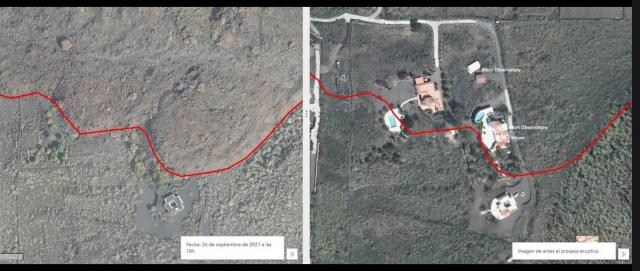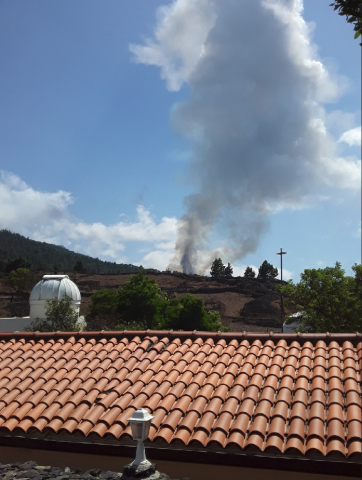Forum Replies Created
-
AuthorPosts
-
 Dr Paul LeylandParticipant
Dr Paul LeylandParticipantI don’t know, to be honest. They were there when I bought it and I have never tried to find out.
 Dr Paul LeylandParticipant
Dr Paul LeylandParticipantSee http://www.astropalma.com/equipment.html
Shows it much better than I can describe it.
 Dr Paul LeylandParticipant
Dr Paul LeylandParticipantMy 120mm refractor / autoguider is mounted on top of the 400mm Dilworth, all inside a dome. As long as I am observing reasonably close to the meridian the scopes are aligned along the slit, not across it. Observing extremely close to the zenith results in the 120mm being hidden behind the slit shutter.
 Dr Paul LeylandParticipant
Dr Paul LeylandParticipantThanks for posting this. A fascinating paper.
Likely useful not just for planetary observers. Obvious DS applications are to clean up globular clusters and galaxy clusters.
 Dr Paul LeylandParticipant
Dr Paul LeylandParticipantThe aim is to create an artificial star of known size and shape. A very narrow laser beam tuned to exactly the same wavelength of sodium light stimulates fluorescence at the same wavelength from sodium in the upper atmosphere. (Incidentally, that sodium comes primarily from sea salt.)
A telescope looking at that fluorescent spot should see an immobile spot with a shape and diameter set by the resolution of the optics. In practice it sees a large shimmering moving blob because of the atmosphere. Clever software quickly works out what distortions should be made to the telescope to return that blob to its undistorted shape and very fast mechanical actuators then make the corresponding movements to an optical element. Voila, diffraction-limited images through adaptive optics.
 Dr Paul LeylandParticipant
Dr Paul LeylandParticipantIf you watch the video feed for long enough you will find that at some times that happens about once a minute. Sometimes the vents do little but leak gently; sometimes they explode and send material hundreds of metres into the air.
Note that the side of the cone has collapsed. I watched much of that happening in real time.
All rather interesting as long as you are at a safe distance.
 Dr Paul LeylandParticipant
Dr Paul LeylandParticipantI have found it majestic and hypnotic but not, perhaps strangely, scary. That’s the case whether watching live or over the net.
Last night (i,e. 24 hours after the above posts) it became markedly more explosive with enormous lumps of lava being thrown a hundred metres or more into the air. It was hard to judge scale but some of those pieces must have been well over a metre in diameter and so weighing several tonnes each. I was also watching what started out as a very minor effusive vent become much bigger and explosive.
 Dr Paul LeylandParticipant
Dr Paul LeylandParticipantExcellent live coverage at https://rtvc.es/en-directo/
It helps if you understand Spanish …
Their live feed from the Cumbre Vieja shows that large amounts of liquid are still coming out but the explosive gouts appear to be somewhat reduced from when we left several days ago.
 Dr Paul LeylandParticipant
Dr Paul LeylandParticipantNot now.
By chance we took out fire / flood / vandalism / etc insurance on our place a week or so before the eruption started. The insurance company didn’t want to touch our observatories so we were going to check for specialist companies when back in the UK.
It is possible to insure almost anything against almost anything if you are prepared to pay the premium.
 Dr Paul LeylandParticipant
Dr Paul LeylandParticipantSPC is now open, for the time being.
 Dr Paul LeylandParticipant
Dr Paul LeylandParticipant
This is a before and after image of an amateur observatory on La Palma. Note the apertures of the telescopes — 80cm and 50cm. Serious kit.
I never met Rico but exchanged email.
29 September 2021 at 6:06 pm in reply to: Image gallery update – better object tagging and search #584745 Dr Paul LeylandParticipant
Dr Paul LeylandParticipantThanks Dominic.
Good work.
Have you updated the list of objects that can be tagged to include the latest asteroids and the solar system satellites?
 Dr Paul LeylandParticipant
Dr Paul LeylandParticipantLatest news: getting there is currently a PITA. The airports at both La Palma and La Gomera (SPC and GMZ respectively) are now closed because of ash from the volcano. The rest of the Canarian airports are still open so you could fly into LPA, TFN or TFS and get the ferry. I wouldn’t bother myself.
 Dr Paul LeylandParticipant
Dr Paul LeylandParticipantThanks Dominic.
You are likely correct about the WHT. I just assumed it might be trying to look at the sky without actually checking on its current status.
Travel to and from La Palma is straightforward for fully vaccinated European citizens. SWMBO and I had no problem getting there in late June and coming back the UK required us to have PCR tests before and after the flight this week. Passenger location forms were required by both the Spanish and UK governments. The tourist industry is recovering and accommodation levels are about 80% at peak; most visitors are from Germany and The Netherlands, but that has long been the case.
 Dr Paul LeylandParticipant
Dr Paul LeylandParticipantKevin’s all-sky camera is reporting a light dusting of ash at Tacande.
The INT and NOT (at least) are not opening up tonight because of ash in the air. Not yet head about the WHT and GTC.
 Dr Paul LeylandParticipant
Dr Paul LeylandParticipantEruption now becoming quite explosive. Pyroclasts reaching 300m in altitude according to my rough and ready observations and trigonometry.
Certainly much noisier and brighter tonight, though the noise is mostly coming in pulses and the background roar is noticeably lower.
 Dr Paul LeylandParticipant
Dr Paul LeylandParticipantNow that more information is becoming available I have been able to pinpoint the location of the eruption to within a few metres. As best I can make out, it is at latitude 28°36’54″N, longitude 17°52’02″W which is 3.2±0.1 km almost due south of here. (Here being Tacande Observatory which is labelled on Google Maps.)
The view is quite impressive after dark but the volcano has caused no trouble at all for Kevin and me as yet.
The location is very close to this point in Google Maps:
https://www.google.es/maps/@28.6154215,-17.8670681,268m/data=!3m1!1e3?hl=en
 Dr Paul LeylandParticipant
Dr Paul LeylandParticipantAbsolutely typical. Politicians always like to come rubber-necking when something mildly interesting occurs.
Further, they invariably promise that help and monetary compensation will be made available instantly. True in this case too.
There is still a very noisy pillar of hot ash visible from the window next to where I am typing.
 Dr Paul LeylandParticipant
Dr Paul LeylandParticipantIt is a bit noisy and we have Bortle 9 skies to the south at present. I now have some more images and a few videos which are perhaps of interest.
Ah well. It all adds a modicum of interest to an otherwise tedious existence.
Incidentally I, SWMBO and two in-laws were stuck in La Palma for several days when Mount Unpronounceable erupted in Iceland a few years aback and closed down almost all European airspace. That one definitely increased the sky background brightness and reduced the transparency in the UK.
 Dr Paul LeylandParticipant
Dr Paul LeylandParticipantIt is noisy and there is a wonderful illustration of the old saying: Red sky at night, vulcanologists’ delight but everything else is just fine. The camera has lost its cooling (as has Kevin’s in the neighbouring dome) so we wouldn’t be observing anyway but otherwise there is no good reason not to open up the domes.
This one is taken within 3 minutes of the start of the eruption. My dome is to the left, Kevin’s to the right, largely hidden by the tree.

-
AuthorPosts
